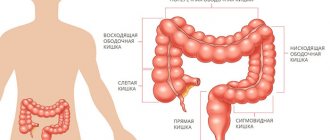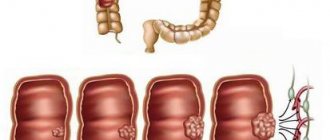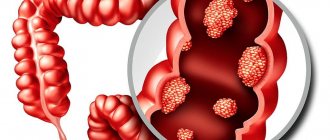The main criterion that allows a patient to be diagnosed with stage 4 intestinal cancer is the presence of distant metastases. In this case, the primary tumor can be of any size; it may or may not grow through the entire intestinal wall. The presence of cancer cells in nearby (regional) lymph nodes is also not a necessary condition.
According to American statistics, every fifth patient with colon cancer already has distant metastases at the time of diagnosis.
As a rule, radical treatment in such cases is impossible. The doctor can only prescribe palliative therapy, which helps reduce symptoms and improve the quality and length of life.
Depending on the number of metastatic foci, stage 4 colon cancer is divided into two substages:
- Stage IVA: Metastasis has spread to only one organ.
- Stage IVB: Metastases have spread to two or more organs.
Most often, colon cancer metastasizes to the lungs, liver, peritoneum, bones, and less often to other organs.
What are the symptoms of stage 4 colon cancer?
The clinical picture consists of manifestations associated with the primary tumor and metastases. Colon cancer is asymptomatic for a long time, and when the first symptoms appear, they often resemble signs of other diseases. Therefore, many patients do not consult a doctor on time, and their tumor is diagnosed in late stages.
With stage 4 colon cancer, the patient may experience the following symptoms:
- Blood in the stool. It has a dark red color, or the stool looks black, tarry, and has an unpleasant odor (melena).
- The stool may become thin and long, resembling a pencil in shape. This suggests that there is a tumor in the intestine that narrows its lumen.
- Change in bowel habits, constipation or diarrhea. These are very ambiguous symptoms, because they occur with many other diseases or simply temporary intestinal disorders. But if they are persistent and persist for a long time, this is a reason for concern and a visit to the doctor.
- Bloating and abdominal pain are usually caused by a tumor blocking the intestinal lumen.
- Nausea and vomiting - with colon cancer, these are most often manifestations of intestinal obstruction.
General symptoms occur. The patient gets tired quickly, constantly feels weak and lethargic. If the tumor constantly bleeds, anemia develops. It manifests itself as pallor, weakness, dizziness, and headaches. For no apparent reason, body weight decreases. If a person eats as usual, but has lost 4–5 kg, this is an alarming sign. With colon cancer, appetite may be greatly reduced.
Prevention
Lifestyle factors can contribute to the development of bowel cancer, so the following lifestyle changes should help reduce your risks:
- body weight control;
- regular exercise;
- maintaining a diet rich in whole grains, cereals, fruits and vegetables;
- reducing consumption of fats, salt and sugar;
- to give up smoking;
- reducing or stopping alcohol consumption.
Bowel cancer develops slowly and, if detected early enough, is limited to parts of the bowel and can be successfully removed. If a person is over 50 years old, an annual screening test will help detect any changes Source: Preventing Stomach and Colon Cancer. V.V. Egorenkov. Practical Oncology, T. 12, No. 2 - 2011..
Article sources:
- Prevention of stomach and colon cancer. V.V. Egorenkov. Practical Oncology, T. 12, No. 2 - 2011.
- Colorectal cancer: a guide for patients. Information for patients based on clinical guidelines from the European Society of Medical Oncology (ESMO). — 2016.
- Expression of the icam-1 gene in tumor cells of patients with colon cancer. Knyazev D.I., Novikov D.V., Sakharnova T.A., Presnyakova N.B., Kuznetsova O.S., Kazatskaya Zh.A., Spiridonova N.A., Alyasova A.V., Novikov V. .IN. Bulletin of Nizhny Novgorod University named after. N.I. Lobachevsky No. 2, 2010. p. 528-531
- Modern aspects of surgical treatment of colorectal cancer. Dauletbaev D.A., Kaliaskarov E.Sh., Menayakov M.T., Serikov N.S., Aubakirov E.A. Bulletin of the Kazakh National Medical University No. 1, 2016, p. 226-229
- Locally advanced colon cancer – aspects of surgical tactics. Kutukov V.V., Sluvko L.V., Sevostyanov V.V. Tyumen medical journal No. 2, 2010. p. 79-80
The information in this article is provided for reference purposes and does not replace advice from a qualified professional. Don't self-medicate! At the first signs of illness, you should consult a doctor.
Symptoms of liver metastases
Often, cancer cells from the intestine enter the liver through the portal vein. At first, while the lesions are small, there are no symptoms. As metastases grow and organ dysfunction occurs, symptoms such as jaundice, itching, swelling in the legs, ascites (fluid accumulation in the abdomen), nausea and vomiting, loss of appetite, pain in the upper abdomen under the right rib, increased fatigue, weight loss occur. .
Lifespan
With effective treatment, the survival rate of patients, depending on the type of tumor, is:
- Stage 4 liver cancer – about 5% of patients live more than 5 years.
- Stage 4 intestinal cancer – 5% of patients live more than 5 years.
- stage 4 lung cancer – 10% of patients survive for more than 5 years.
- Stage 4 stomach cancer – 6% of patients live more than 5 years.
- stage 4 pancreatic cancer – 10% of patients live more than 5 years.
- Stage 4 breast cancer – 15% of women survive more than 5 years.
- Stage 4 breast cancer – 15% of patients live more than 5 years.
- Stage 4 uterine cancer - depending on the spread of the process, the survival rate ranges from 3 to 9%.
- Stage 4 cervical cancer – 8% of women live more than 5 years.
- Stage 4 prostate cancer has a high five-year survival rate, about 30%.
The Oncology Department of the Yusupov Hospital in Moscow provides treatment for cancer at all stages of the disease. The diagnostic center and doctors of the oncology department make every effort to provide timely assistance to cancer patients. Seeing a doctor promptly can save your life. You can make an appointment for a consultation by phone.
Symptoms of bone metastases
Depending on the location of bone metastases, persistent pain in the arms, legs, neck, back, and lower back is bothersome. Weakening of bones threatens pathological fractures: they occur when exposed to small mechanical loads, from which healthy bones do not break.
The tumor destroys bone tissue, which causes calcium to be washed out into the blood. Hypercalcemia develops, which manifests itself in the form of decreased appetite, nausea, and constipation.
Painkillers
The symptom that most clearly indicates the development of a malignant tumor is pain. An actively growing tumor most often causes pain. Pain can be caused by damage to the nervous tissue, the development of an inflammatory process in the tumor. To alleviate the patient's condition, pain medication is administered. It is prescribed individually, taking into account the patient’s condition, and can significantly reduce the intensity of pain. Pain relief for stage 4 cancer:
- If mild pain occurs, non-steroidal anti-inflammatory drugs are prescribed.
- pain of moderate intensity is treated with combination drugs: ketorol and other potent drugs.
- severe, debilitating pain is treated with the help of strong drugs containing narcotics - fentanyl, morphine, promedol.
Symptoms of peritoneal damage
The peritoneum is a thin film of connective tissue that covers the intestines and other abdominal organs and lines the inside of the abdominal wall. In stage 4 colon cancer, if tumor cells break away from the primary tumor and spread to the peritoneum, the condition is called peritoneal carcinomatosis. It greatly worsens the patient’s condition and prognosis, and reduces the effectiveness of antitumor therapy.
Peritoneal carcinomatosis leads to ascites, a condition in which fluid accumulates in the abdominal cavity. Because of this, the stomach enlarges externally and the functioning of internal organs is disrupted.
Stages
When signs of bowel cancer appear, it is important to determine the stage of the disease, since the choice of treatment strategy directly depends on this. There are four main ones, to which the so-called zero stage is often added - the stage at which benign neoplasms (polyps) or chronic inflammation with erosion of the mucous membrane appear in the intestine. These conditions often become precancerous.
- The tumor does not exceed 2 cm in size and is located within the mucous membrane. Lymph nodes are not affected.
- The size of the tumor increases to 5 cm, the malignant tissue spreads into the submucosal layer. Two or three regional lymph nodes are affected, there are no metastases.
- The neoplasm grows up to 10 cm, penetrates the muscle layer of the intestinal wall, but does not extend beyond the organ. Partial or complete occlusion of the intestinal lumen is possible. Almost all regional lymph nodes are affected, and metastases are found in nearby organs.
- The tumor grows more than 10 cm, grows through all layers of the intestinal wall and penetrates into neighboring tissues. The breakdown of cancer tissue begins with the spread of cancer cells throughout the body - to distant lymph nodes and organs. The presence of distant metastases is the main sign of the fourth stage, regardless of the size of the cancer tumor.
How is stage 4 colon cancer diagnosed?
The primary tumor is detected using colonoscopy, an endoscopic examination during which a colonoscope, a special instrument in the form of a thin flexible tube with a miniature video camera and a light bulb at the end, is inserted into the colon. During a colonoscopy, the doctor can perform a biopsy: obtain a fragment of tumor tissue for histological and cytological examination.
In order to find distant metastases, additional diagnostic methods are used:
- Chest X-ray can help detect secondary lesions in the lungs.
- Ultrasound examination reveals metastases in the liver, other organs of the abdominal cavity and pelvis.
- CT and MRI are used to examine the organs of the chest, abdomen, and pelvis. For better visualization, a special contrast agent may be injected into the patient's body.
- PET scanning is the “gold standard” for diagnosing metastases in modern oncology. During the study, a radiopharmaceutical—a “radioactive tracer”—is injected into the patient’s body. This drug is safe for the body; it accumulates in cancer cells. Thanks to this, even the smallest lesions become visible in images taken with a special apparatus.
Diagnostics
Your doctor may recommend several tests to accurately diagnose colon cancer.
Correctly diagnosing colon cancer may require patience as doctors use many tests to identify and locate the cancer.
If doctors identify cancer in a specific organ, they expand the range of tests to see if it has spread to other organs.
Tests and processes that can help diagnose colon cancer include:
- physical examination
- blood tests
- colonoscopy of the rectum
- a biopsy, in which a doctor takes a tissue sample and sends it to a laboratory for analysis
- molecular testing to help identify specific tumor characteristics that may be important for treatment
- imaging tests such as CT, PET-CT, ultrasound and MRI to see if the cancer has spread to other organs
- X-ray of the chest to check if the cancer has spread to the lungs
After performing all the necessary tests, the doctor will discuss the diagnosis with the patient.
Treatment of stage 4 colon cancer
Stage 4 cancer is very difficult to treat. As a rule, radical treatment is not possible. Doctors use palliative measures that help cope with pain and other symptoms, improve the patient’s condition, and prolong his life.
The most favorable, but, unfortunately, rare situation is when stage IV colon cancer has single metastases that can be removed surgically. Sometimes this results in remission. During the operation, the surgeon removes the area of the intestine affected by the tumor, regional lymph nodes, and metastases. Adjuvant and neoadjuvant chemotherapy and intra-arterial administration of chemotherapy drugs for liver damage are often prescribed.
In most cases, it is impossible to remove metastases, because there are a lot of them, and many are small in size. In this case, the following treatment methods are used:
- Palliative operations. The surgeon may remove the area of intestine blocked by the tumor or install a stent, a hollow cylindrical frame made of metal or polymer material that widens the lumen of the intestine. Some patients are indicated for a colostomy: during this intervention, the doctor sutures a section of the colon to the wall of the abdominal cavity and forms an opening in the skin (colostomy) through which stool passes. If a portion of the small intestine is blocked by the tumor, a bypass anastomosis may be performed.
- In case of liver damage, chemoembolization and radiofrequency ablation are used.
- Chemotherapy is prescribed to most patients with stage 4 bowel cancer. Different combinations of chemotherapy drugs are used: FOLFOXIRI (leucovorin + 5-fluorouracil + irinotecan + oxaliplatin), CAPEOX (oxaliplatin + capecitabine), FOLFIRI (leucovorin + 5-fluorouracil + irinotecan), FOLFOX (leucovorin + 5-fluorouracil + oxaliplatin).
- Targeted drugs: bevacizumab, ramucirumab, cetuximab, panitumumab, regorafenib.
- Immunotherapy. Pembrolizumab (Keytruda) is a monoclonal antibody drug that is a checkpoint inhibitor. It blocks molecules that malignant tumors use to suppress the immune system.
- Painkillers. With advanced cancer, many patients experience excruciating pain, so it is important to prescribe effective pain relief. Different types of drugs are used. If the “softer” ones don’t help, they switch to more powerful ones, even narcotic analgesics.
- Radiation therapy helps slow tumor growth and reduce pain.
A serious complication of stage 4 colorectal cancer is ascites, a condition in which fluid accumulates in the abdominal cavity. They resort to laparocentesis - a procedure during which a puncture is made in the wall of the abdominal cavity and excess fluid is removed. Various surgical interventions are performed to help prevent relapse of ascites. A modern treatment method (but it is very complex and cannot be used in all patients) is HIPEC, hyperthermic intraperitoneal chemotherapy. First, an operation is performed during which all visible lesions in the abdominal cavity are removed, then the abdominal cavity is washed with a heated chemotherapy solution, this helps to destroy the remaining cancer cells. HIPEC is only effective when the cancer is located within the abdominal cavity.
Development of metastases
When the problem develops to the level of stage 3 cancer with metastases, the tumor becomes very active, quickly increases in size, growing into nearby tissues. In most cases, screenings are observed in distant lymph nodes. The prognosis takes into account factors such as the degree of differentiation and location of the tumor, and the general condition of the patient. These moments can both aggravate and reassure the patient’s situation. Successful treatment here is still quite possible.
Survival prognosis for stage 4 colon cancer
Five-year survival depends on the type and stage of the tumor. For stage 4 colon cancer, this figure is 12%, for rectal cancer - 13%, for small intestine cancer - 4-5%. It is difficult to say in advance which of the patients will fall into this small percentage and will remain alive for five years or longer from the date of diagnosis. But everyone can help. Even if a person’s life could be extended by a couple of weeks, this is already a victory. It's worth fighting for.
Book a consultation 24 hours a day
+7+7+78
Causes and risk factors
The mechanism of development of intestinal cancer has not yet been precisely established. However, the factors that increase the likelihood of the disease have been studied quite well. Among them:
- inherited predisposition;
- the presence of polyps in the intestines;
- chronic inflammatory diseases - Crohn's disease, ulcerative colitis, diverticulosis, chronic obstruction;
- unbalanced diet with excessive amounts of red meat, smoked meats, spicy seasonings, fatty and fried foods;
- exposure to ionized radiation, carcinogenic compounds;
- obesity, sedentary lifestyle;
- age over 45 years.
How long do you live after surgery?
The prognosis for life expectancy after removal of a tumor in the rectum will depend on the stage of the oncological lesion, age and the nature of the treatment performed. The disease, detected at stages 1-2 of the lesion, and surgery in the early stages, give the surgeon the opportunity to remove the tumor and the first minor metastases that do not affect vital organs. In these cases, 65-85% of young patients recover completely, and the rest have from 2 to 5 years of full life.
The likelihood of cancer recurrence sharply decreases after 5 years after surgery, so this period is considered critical. If more than 5 lymph nodes are affected or with metastases in neighboring organs, liver and lung tissues, there is very little chance of extending the patient’s life. In these cases, they do not live to see a year.
The postoperative recovery period also plays an important role in patient survival. In a short time, it is necessary to restore the patient’s body after surgery and chemotherapy with the help of nutritional therapy, and to prevent relapses of the disease.
Causes of the disease
Colon cancer most often begins with benign polyps (adenomas). Oncology can develop both inside the intestine and spread beyond it, affecting surrounding tissues.
Risk factors for developing colorectal cancer:
- Age—the risk of developing the disease increases with age. Before age 40, a diagnosis of colorectal cancer is very rare. The risk increases after age 50, with peak incidence occurring in the eighth decade of life.
- Obesity (in people with a body mass index (BMI) greater than 30, the risk of developing the disease increases by 50-100 percent compared with people of the same weight, that is, a BMI below 24.99);
- Unhealthy diet high in animal fats, red meat and processed foods and low in vegetables, fruits and dietary fibre;
- Low physical activity;
- Smoking (it is estimated that up to 20% of colorectal cancer cases are related to smoking);
- Previous radiation therapy to the abdomen;
- Taking immunosuppressants after organ transplantation;
- Alcohol abuse;
- Previous gallbladder removal;
- HPV (human papillomavirus) infections;
- A history of cervical, vulvar, or vaginal cancer.
A tendency to intestinal cancer can be inherited. Yes, genes, along with a poor lifestyle, are the most common cause of colon cancer. It is estimated that 15-30% of colorectal cancer cases are genetic.
However, genetic factors are not just the fact that someone in the family previously suffered from colorectal cancer and could pass on the defective gene to their descendants.
Genetic factors also include:
- familial adenomatous polyposis syndrome, which is considered a so-called precancerous condition (colorectal cancer develops in 75-95% of patients with familial adenomatous polyposis);
- Lynch syndrome (formerly called hereditary nonpolyposis colorectal cancer). This is the most common cause of genetically determined colorectal cancer, accounting for 1-3% of cases;
- inflammatory bowel diseases (for example, ulcerative colitis increases the risk of colon cancer by 20 times).
IMPORTANT:
Patients with a family history of colorectal cancer, especially those over 40 years of age, should undergo annual medical examination and genetic testing.










